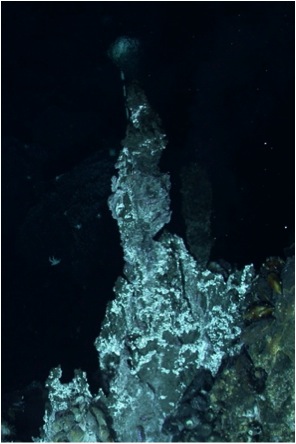
One of the main focuses of this cruise has been to continue studying the ecology of thermoacidophilic (heat and acid loving) microorganisms at deep-sea hydrothermal vents. This unusual physiology was first discovered in these environments following our last trip to the Eastern Lau Spreading Center (ELSC) in 2005. Specifically, Aciduliprofundum boonei was isolated and characterized from a sulfide sample collected from the “bench top” area of the Mariner vent field. Photo 1 (above)- Electron photomicrograph of Aciduliprofundum boonei, from Reysenbach et al., 2006.
What made this discovery so exciting was that thermoacidophiles had been predicted to exist in these environments based on geochemical models of sulfide chimneys but had never been identified prior to the characterization of A. boonei. Additionally, A. boonei belonged to a lineage of the Archaea (the deep-sea hydrothermal vent Euryarchaeota 2, DHVE2) that has only been found in deep-sea hydrothermal systems suggesting that some microbial species may be endemic to these environments as has been observed with several vent animals. Photo 2 (below)- Phylogenetic relationship of the DHVE2 within the Euryarchaeota based on 16S rRNA gene sequences, from Reysenbach et al., 2006.

Since those initial discoveries, we have sequenced and analyzed the genome of A. boonei, revealing a strictly fermentative metabolism based on amino acids (proteins) as carbon and energy sources. We have also isolated several new species of the DHVE2 from the Mid-Atlantic Ridge (MAR) and the East Pacific Rise (EPR). Molecular techniques such as quantitative polymerase-chain reaction (QPCR) and high throughput pyrosequencing have revealed interesting insights into the relative abundance of the DHVE2 and community composition of individual sulfide structures along the MAR. Photo 3 (below)- Example of a flange structure collected from the Lucky Strike vent field along the MAR in 2008 where the DHVE2 were found.

Our goal for this current expedition is to continue building upon our data set on the occurrence and distribution of thermoacidophiles and how the geology of specific vent types help to shape distribution patterns. In this regard, the ELSC provides a unique opportunity because the underlying host rock varies from north to south and is different from both the MAR and EPR.


